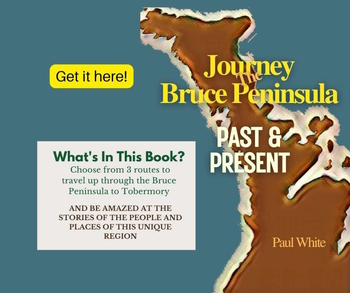Meaford Ontario:
The Early Years
Meaford Ontario was first called Peggy's Landing named after the wife of the first settler on this small Georgian Bay harbour community.
In the early 1830s the colonial government decided that it was time to open up the Grey/Bruce region to meet the ever-increasing clamor for more settlement lands. The first area surveyed in 1833 was given the rather interesting name of “Zero”.
Although the initial survey occurred in 1833 it was not until seven years later in 1840 that the first settler, David Miller, arrived. In that intervening period the name Zero had disappeared from the surveying maps of the colony and was replaced with a new name, St. Vincent.
The survey had designated a plot of 200 acres at the mouth of the Big Head River for a town site. Soon after Miller’s arrival the area around his homestead came to be known as Peggy’s Landing, named after Miller’s wife. In 1845 this unofficial name for the area disappeared when the colonial government assigned William Gibbard to subdivide the town plot. One of Gibbard’s first actions was to name the new settlement Meaford.
The first post office in the area was established at the new community and although it was located in Meaford the government assigned the name St. Vincent to the post office. This caused a great deal of confusion until the post office was finally named Meaford in 1867.
The first postmaster, William Stephenson, must have been a man of incredible fortitude. In order to get the mail for the settlers in the region he had to walk to Barrie. Stephenson’s post office was the only one in the area. Consequently, settlers from the Owen Sound region had to walk to Stephenson’s to pick up their mail.
Meaford’s location on Georgian Bay and the rich land surrounding it attracted many settlers. By the time it was incorporated as a town in 1874 the community boasted a population of 1700. The presence of the Big Head River encouraged the development of an industrial and commercial base. Perhaps the first to recognize the value of the river was the son of the first settler, David Miller, Jr., who erected a grist mill about a mile upstream.
The port facility also proved to be an attraction to both prospective settlers and the establishment of business enterprises. Around the turn of the last century, activity around the harbour increased when the Grand Trunk Railroad moved its depot from Station Hill to the waterfront.
In the 1870s, Meaford Ontario was an important fishing port on Georgian Bay. One of biggest operations in the area was owned by Gilbert McIntosh who fished the waters between Meaford and Tobermory. In the beginning he brought his catch back to port in the seventeen-ton vessel, “Rescue”, but in order to keep up with market demands, in 1885 he added the thirty ton “Alfred Morell”, and shortly thereafter the 50 ton “G.P. McIntosh” to his fleet.
The agricultural and industrial produce of the region, as well as fish, attracted many commercial vessels to call at Meaford’s docks. However, around 1900 a new product proved to be an even greater attraction for the Great Lakes’ commercial fleet.
The establishment of fruit orchards in the area proved to be a successful venture for many area agriculturalists and the annual apple harvest provided another benefit for the economy of the area. Ships that had never called at Meaford Ontario before, now made stops there to pick up fruits for transshipment throughout the Great Lakes region.
It began as a part of “Zero”. Next it was known as Peggy’s Landing. The government allowed it to suffer for two decades under the split personages of Meaford and St. Vincent. Finally, in the year of Canadian Confederation, the confusion ended with the decision to call the community Meaford. Whatever its name, the Meaford Ontario area has a rich and dynamic history!
A version of this Meaford Ontario story first appeared in my Owen Sound Sun Times' Local History column
More Grey County Pages
12-year-old Walks to Owen Sound in 1851 from the journal of a teenage boy's experience travelling with his brother in the untamed Upper Canadian wilderness.
1st Grey County Building in 1852 was only built after many hurdles were overcame.
Dr. Anna Henry from Markdale, was a medical trailblazer for women doctors in Canada, who helped lay the groundwork for the establishment for Women's College Hospital.
Egremont Township endured the usual growing pains of a pioneer community, but its early history records times when it was embroiled in a few contentious issues.
Euphrasia Township in the early years when spelling the name was a problem for those who called it home and those that wanted settle this new Grey County township.
Georgian Bay's 1st pioneer settler arrived on the western shoreline long before any other settler reached the area.
Grey County Heritage: A Valuable Resource which is rich and varied, as an important resource for future use for business, political, and many other purposes.
Grey County's Creation in 1852, laid the framework for organizing a county in the last wilderness in the southern region of what would become in the future the province of Ontario.
An Unlikely Hero From Grey County (Part 1) found his way from the farming community of Flesherton to missionary work in the Ottawa Valley, and beyond.
An Unlikely Hero Vs. The KKK (Part 2) Our hero from Grey County took his missionary zeal south of the border and ultimately crossed paths with the infamous KKK!
Barn Raising: A Pioneer Economic and Social Necessity as it provided settlers with an opportunity not only to build a barn, but also build a community.
"Barring Out": A Pioneer School Tradition was a custom which the settlers brought to the new world from England, or Scotland.
Ceylon Ontario: How it Got its Name: It is always interesting how a community got its name, but I doubt any place received its name from a more unique source!
Chatsworth Ontario: First Settlers took advantage of fulfilling the needs of pioneer travellers and built a thriving community in the Upper Canadian wilderness.
Clearing Trees a Daunting Task for Settlers as they worked to fulfill their obligations for their land grant.
Dornoch: or is it Smithville? Originally it was Smithville, then it became Dornoch. But, surprise it is still, in reality Smithville!
First Pioneer in Durham: Archibald Hunter established his family, and a hotel, in what would become the centre of the town of Durham.
Durham Ontario Influenced by the Saugeen River. This river provided a means to create new industries, but especially in the spring it can also pose a menace to the community.
Grey County Bylaws to the 1890s reveal a lot about the financing of local government, especially education in the early days of the region.
John Muir, the legendary naturalist, who promoted the idea of protected nature spaces, spent time in Ontario and I went to help find evidence of his stay in the Owen Sound area.
A Heroic Woman From Grey County who made great changes as a doctor in China in the 1890s and early 1900s.
Jesse James: In Grey County? An interesting question. Did the notorious gangster hide out in Proton Township? We will never know. But it is fun to speculate!
Kilsyth's Train Engine was one for the history books. It brought an evening of joy followed by disappointing news soon after.
The Knight's of Meaford have long history in that Grey County community. Their business forged by early settlers employed many locals and supported the economy.
Leith: Tom Thomson's Birthplace is part of the rich heritage of this community located on the east shore of the Georgian Bay north of Owen Sound.
The Leith Golf Course has provided many families with great memories. The history of this golf course starts, and ends, with the generosity of one family.
Agnes Macphail was a political trailblazer in a part of Ontario that one could hardly expect such radical action for the era in a rural region.
Markdale Ontario: The Beginning: originally known as Glenelg East, but the coming of the railway and the name of owner of the land for the station led to a change of identity.
Meaford's history is one of hardy and entrepreneurial pioneers carving their lives out of the wilderness of what would become Grey County.
Meaford Ontario, first called Peggy's Landing located on the shores of Georgian Bay has a rich history.
Meaford vs Purdytown. Conflict over the name of a new community was not unusual in early Grey County but electing a school trustee was the "hot button" issue in this rivalry.
Pioneer Clergyman: John Neelands was the first to minister to the first settlers' spiritual needs riding on horseback through the wilds of early Grey County.
Pioneer Doctor: Dr. James Smith, a local boy who became a doctor and served his community for his entire life was a testament to Grey County community spirit.
Pioneer Healthcare in Grey and Bruce counties was not administered by doctors, nurses, or pharmacists, no it was the responsibility of the women of the community.
Pioneer Homes in Grey County in the 1840s offered only basic amenities. Homes were basic because clearing the land to earn a living to survive were of paramount importance for those embarking on a new life.
Pioneer Ingenuity created many labour saving devices and methods and quite often helped to create a sense of community.
Pioneer Christmas: A Family Tradition as told to me by may grandparents who experienced Christmas as children in the 1880s and 1890s.
Pioneer Settlement Plans for Grey County began almost two decades before the rest of Grey County was available for settlement.
A pioneer road surveyor's impact on the local history of Grey and Bruce counties could have been dramatic, if it had not been changed by another surveyor.
Pioneer Teachers in Grey and Bruce Counties had a long and arduous task, not to mentions strict and confining job requirements for very little salary.
Plowing Match in Grey County in 1933 the first International Plowing Match held in Grey and Bruce counties and it's success led to more such events in Grey.
Settling Osprey Township: Parts of Osprey were considered too rugged to settle, but today they are prime real estate because of the great view!
Swamp College: Proton Township: this colourfully named institution of education in Grey County has provided many stories to the heritage of the region.
Sydenham Township's First Council undertook the often difficult task of creating a new municipal infrastructure.
The Impact of Snow is not what is Used to be! As snow removal equipment has improved the impact of snow on our lives has reduced significantly from previous eras.
Unique Characters: Nathaniel Herriman lived in Grey County and owned an inn to provide food and and accommodation to early travellers. Each day he performed a unique practice.
Unique Maps: Quilts Guided the Underground Railroad to enable runaway slaves to escape to Canada and freedom from the shackles that enslaved them.
The Women's Institute is a group of rural women that has made a difference to the quality of both urban and rural life in Grey County and across the country.





